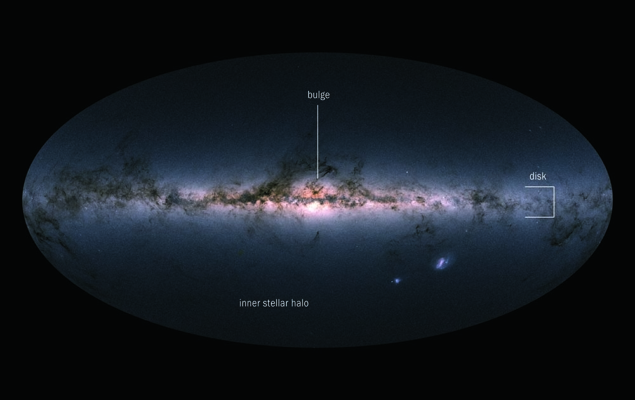
Many of the stars appearing in the night sky did not originate from within our galaxy, concludes a new study of data from the European Space Agency’s Gaia observatory. Instead, Gaia has found evidence that these stars formed in a smaller galaxy that merged with ours about 10 billion years ago.
Gaia was launched in 2013 with the aim of measuring the positions and distances of more than one billion astronomical objects (mainly stars) in and around our galaxy with unprecedented precision. Using Gaia data containing about seven million stars, Amina Helmi of the University of Groningen in the Netherlands and colleagues have found that a subset of these stars is different from the bulk of the stars in the Milky Way. Earlier research had shown that some stars in the galaxy’s inner stellar halo, which surrounds the central bulge and disk, have different chemical abundances from the bulge and disk stars (see figure). But the latest study found that these halo stars also exhibit orbits around the galactic centre that differ significantly from the rest of the stars.
The orbits of the stars in a galaxy typically follow that of the gas cloud in which they were born, which means that a proto-galaxy consisting of an orbiting gas cloud will produce stars orbiting along with the cloud. However, Helmi and co-workers show that many of the Milky Way’s halo stars orbit backwards relative to the rest of the galaxy, suggesting that their origin is probably different. The team then compared the Gaia observations with simulations in which the Milky Way merged in the past with a smaller galaxy with 25% of its mass, finding a remarkable similarity between the observed and simulated orbits.
Additional analysis of spectral data from APOGEE-2 (Apache Point Observatory Galactic Evolution Experiment), which is part of the Sloan Digital Sky Survey, revealed that the halo stars contain fewer of the chemical elements that are produced in specific types of supernovae, indicating that they are significantly older than the bulk of the Milky Way’s stars.
Taken together, the results suggest that, after the smaller galaxy (named Gaia–Enceladus by the authors) merged with the Milky Way, it lost all the gas it needed to produce new stars. As a result, only the old stars survived and no new stars were born. The age of the youngest stars from Gaia–Enceladus – about 10 billion years – can therefore tell astronomers when the merger took place. A final piece of evidence that this dramatic event occurred comes from Gaia data of 13 star clusters orbiting the Milky Way at large distances. The orbits of these clusters, which contain millions of gravitationally bound stars, match those that would be expected for the remnants of Gaia–Enceladus.
The results, published in Nature, constitute one of the first major discoveries to emerge from Gaia data. They shed light on the origin of our galaxy and galaxy mergers in general, but much more will no doubt be learned from the vast amount of data that the satellite has gathered.
Further reading
A Helmi et al. 2018 Nature 563 85.







